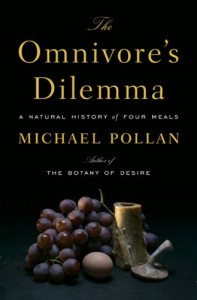Did you know that the koala, the pickiest eater on Earth, has a brain so small that “doesn’t even begin to fill up its skull”? The variety of one’s diet correlates with the size of one’s brain. Whether the reason might be the low nutrition (which makes it more economical to shrink your brain and conserve energy) or the simplicity of a diet that requires no thinking (when you see the food world as eucalyptus and non-eucalyptus, what to have for lunch is not a very big question), the koala’s brain would have been a lot more developed had it been an omnivore. (Whether being smart is better than sleeping 20 hours a day is a different question.)

The Omnivore’s Dilemma is about choice. This theme I did not quite grasp when I read the first part (Industrial – Corn) a year ago (or maybe longer, when you grow old everything seems like just yesterday). I was on the plane flying back to San Francisco, reading this monumental Michael Pollan book and discussing with a Chilean guy across the aisle about negligent governments, undereducated denizens and public apathy. What does that have to do with food? It actually has everything to do with food. The meat, eggs, cereals and virtually anything you buy from a grocery store are produced with corn in one form or another, thanks to government subsidies, big corporations, our desire for “cheap” abundance, and sadly, overzealous science.
The humans, omnivores with brain circuitry so complex to devise ways to modify corn into everything, have managed to reduce themselves to monoculture eaters, which, if you look at it objectively enough, is not all that different from the koala. The depressing part about it is that for a city dweller, you actually have very little choice in what you eat. You can’t escape from eating something that is detrimental to both your body and the whole ecosystem, or at least that’s what the first part of the book, Industrial – Corn, led me to think.
The first part was just painful to read, which is probably why I dropped it after that flight. In few words, we followed steer numbered 534 from his mother’s side into the feedlot where he would never see another blade of grass. He would be given corn that his rumens were not biologically structured to process, and lots of drugs to keep him from falling ill from the corn and the waste in which he stands knee deep.
Recently, I gave myself a day off when I was determined not trying to produce anything, so I picked up the book again. As I chugged past the corn part, thankfully, things got brighter. Humankind hasn’t completely destroyed the earth yet. There are alternatives to industrial corn-fed beef and fossil fuel fertilized vegetables. The sad part though, is that every choice of an omnivore in this modern age comes with a different moral cost:
– Buy foods from the grocery store? You’re supporting big corporations and destroying the land. Even if you buy “organic” products from Whole Foods, those organic products come from large-scale industrial farms that damage the earth with excessive irrigation instead of pesticides.
– Avoid meat to reduce carbon footprints and protect the environment? Your vegetable, if comes from grocery stores, take tremendous amount of petroleum to produce and transport across the country.
– Avoid meat to avoid killing animals? Chapter 17 (The Ethics of Eating Animals) goes into great lengths about this. If you eat only vegetables, you are still damaging other life forms: “the grain that the vegan eats is harvested with a combine that shreds field mice, while the farmer’s tractor wheel crushes woodchucks in their burrows and his pesticides drop songbirds from the sky; after harvest whatever animals that would eat our crops we exterminate”. If you eat seafood, think of how many shrimps or crabs you eat in one meal, why would you value the life of a shrimp less than that of a cow? If you eat dairy and eggs, read pages 317-318 for a brief description of the life of egg-laying hens and the cruelty “required to produce eggs that can be sold for 79 cents a dozen”. (It’s so cruel I could barely read it, let alone paraphrasing it here.)
– Buy foods from local farmers market? This choice is the best to the environment, the plants and the animals, but it is neither practical nor available to everyone. If I walk home with a bag full of artisanal products from farmers market and not give some money to the old man handing out 1-dollar newspapers at the street corner, I feel awful. And there’s about one homeless man per street corner in downtown Berkeley. Then there’s the poor neighborhoods to the south and west parts of the city. Then I think about the people who live in “food deserts” with virtually no fresh produce to buy. To preach about the necessity of choosing a good food source seems somewhat inconsiderate, if not inhumane, to others who can’t afford to be picky.
– Eat chemicals? This option was not listed in the book. But a few months ago I read about this man who invented “soylent”, a mixure of “vitamins, minerals, macronutrients, oligosaccharide, olive and fish oil, antioxidants and probiotics”. At first I thought that was the worst food invention ever. But taste and nutrition aside, could it be the best option to be environmentally friendly and humane to animals (except to fish)? After all, we have for too many years tried to feed the soil and the plants with chemicals that we think are sufficient, in the form of phosphor, nitrogen and potassium fertilizers, so why don’t we do the same to our bodies?
– Grow, hunt and gather your own food? Michael Pollan went as far into the food spectrum as making a meal from only things that he hunted, foraged from the woods, or grew in his garden, noting that of course this option is the most impractical and improbable of all for the modern omnivore, but also the most rewarding.
I’ve always opposed the idea of hunting, but not too much now after I read the book. When at one end of the spectrum you’re pressed against the cruelty of industrial animal farming, where neither the producer nor the consumer spare any thought at all for the animals, much less mercy, and at the other you’re absorbed into a wealth of appreciation from the hunter toward his prey, hunting is no longer pure evil. The beauty of this book, beside the plethora of facts and theories, is its linear structure, which clearly shows where in the choice spectrum (from McDonald’s chicken McNuggets to self-foraged morels) an omnivore should stay without saying it explicitly. The Omnivore’s Dilemma was written in 2006, and here I am, 7 years later, still facing the same spectrum. Taking inflation into account, industrial food is still cheap all the same (which means the production still sucks all the same), and buying from farmers markets is still considered a “foodie” activity far from being mainstream.
So I thought about what I should eat. After thinking of all of the animals and plants I have indirectly killed, I wanted to get myself out of the killing, if only just for a little. I decided to try a fruit-and-grain-only diet. We’ll see how that goes.



Leave a Reply